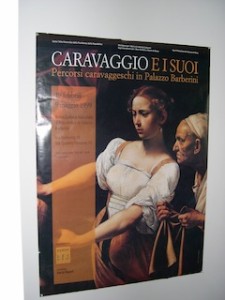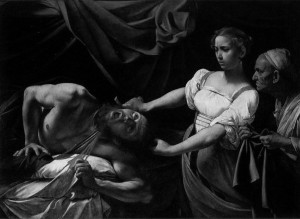A few months ago one of my colleagues, a professor of Renaissance art, was clearing out his office in preparation for retirement, an exercise that required some persistence as he had accumulated piles of books, periodicals, posters, and slides over a twenty-five-year period. He approached me in the hallway with a long roll of paper, which I took to be an oversized poster from a museum publicity campaign, handed it to me and said, “Can you use this?” Unfurling the tube, I was intrigued to find a highly charged drama consisting of two women with their eyes and hands directed towards an unseen adversary at lower left. The dark palette, concentrated expressions, and period costumes made the image instantly recognizable as a fragment of Michelangelo Merisi da Caravaggio’s Judith Beheading Holofernes (1598-99). Large letters at the top announced an exhibition: “CARAVAGGIO E I SUOI / Percorsi caravaggeschi in Palazzo Barberini,” which can be translated as “Caravaggio and His Own [i.e. Followers]: Caravaggesque Journey at [i.e. through] the Palazzo Barberini,” held at the Galleria Nazionale d’Arte Antica di Palazzo Barberini, Rome, from mid-February to early May 1999. Not having attended the event, I wondered what to make of this singular quotation from high art and the collective claim of the appended text.
First to the poster measuring around three and a quarter by four and a half feet. The anonymous designer doubtless selected the striking pair of Judith and her maidservant carrying out an unpleasant deed in the darkness in order to foster interest in the exhibition. Desire is generated on at least four levels: there is the desire to see a masterpiece by Caravaggio; to follow a disturbing narrative through to completion; to view a naturalistic portrayal of an alluring young woman together with her opposite; to see additional examples of such fare. Yet the text is somewhat at odds with this imagery: in highlighting the message of “Caravaggio and His Followers” concurrent with the illusion of two women engaged in a brutal act, the designer suggests that several early seventeenth-century European painters can be grouped together by (a) a shared interest in naturalism and emotion, which is probably true given the requirements of the Catholic Council of Trent and the popularity of the baroque biblical narratives throughout Southern Europe, and (b) a shared interest in attractive female figures engaging in disturbing yet heroic deeds on behalf of the state, which is questionable but seems particularly misplaced here given the unusual direction of Caravaggio’s life and oeuvre.
Second to the catalog published by Electa Napoli. The authors were determined to foreground Caravaggio as the titular leader of a school of great artists and to represent the broadest spectrum of tenebrist practice: southern painters like Giovanni Baglione, Orazio Borgianni, Carlo Saraceni, Orazio and Artemisia Gentileschi, and Bartolomeo Manfredi are included alongside northerners such as Valentin de Boulogne, Hendrick Ter Brugghen, and Judith Leyster. Yet the authors pass over the issues raised by the discordant juxtaposition of image and text in museum publicity and the catalog cover. Caravaggio’s Judith Beheading Holofernes is not even included in the volume, and three other works by his hand—Narcissus (1597-99), St. John the Baptist (1603-04), and St. Francis (1606)—are apposite in subject, featuring solitary male figures respectively distinguished by intense self-regard, erotic vulnerability, and mor[t]al introspection. Would not this selection have presented a suitable opportunity to explore not only Caravaggio’s artistic practice and conceptual approach but also his relationship to his young male models, his sexual desires and anxieties, and the moral dilemma these may have posed for a catholic? That Caravaggio’s detested rival, Baglione, was also featured with Sacred Love and Profane Love (1602), a tenebrist composition of two winged adolescents drawn together with serpentine limbs, intricate gestures, and sexually ambiguous gazes, suggests that more have been going on between the painters and/or their sitters than professional friction over the use of the dark manner!
If the “followers” are continually paraded to evoke the popularity of the “master’s” approach, how will Caravaggio ever be appreciated on his own terms? Richard Spear, Howard Hibbard, and others have pointed out that Caravaggio had only a few trusted friends, refused to take pupils, intimidated those (including Baglione) who experimented with his style, and declared Bernardino Cesari and Annibale Carracci (established classicists) to be among the best painters. Because he was largely absent from Rome after 1605, he had little opportunity to see his approach spread to established painters Borgianni, Saraceni, and O. Gentileschi. Therefore, Judith Beheading Holofernes may be best appreciated in the context of his personal and professional output, somewhere between the languid boys and epicurean Bacchuses of the mid-1590s and the saintly visions, conversions, and martyrdoms of the early 1600s. The two streams are tributary to the same torrent within Caravaggio, the product of an unconventional person[ality] adrift in the alternately permissive and repressive spaces of early modern Rome.
Third to the painting measuring four and three quarters by six and a half feet. The Apocryphal story of Judith, a Jewish widow from Bethulia, defeating the powerful Holofernes, an Assyrian general besieging her city, was a popular subject for artists riding the wave of Counter-Reformation militancy because it encouraged fortitude in the face of danger or suffering and self-sacrifice for one’s people and faith. Adorning herself seductively, Judith set out with her maidservant for the enemy lines and, upon reaching them, claimed to be a defector bent on the destruction of Israel. She gained entrance to Holofernes’ tent and, in the course of several days, dispelled his suspicion and kindled his desire. One night he drank too much and fell into a stupor, at which point she seized his sword, cut off his head, conveyed it to a sack, and returned home in the early hours. When the Assyrians heard the news, they became demoralized and disorderly, and the Israelites were able to drive them from the region.
Caravaggio selected the climactic moment for representation. Two full and one partial torso are interlinked in an undulating wave of tension from left to right, starting with Holofernes struggling to rise from bed at the shock of finding his throat being cut, Judith firmly grasping his hair with one hand and sawing his neck with the other, and the servant ready to catch the meaty prize in a cloth. While there are some discrepancies in the rendering of anatomy (e.g. Holofernes’ neck seems improbably circular in cross-section, Judith’s right arm seems illogically joined to her shoulder), the varied surfaces of skin, hair, and fabric are fluidly, even gracefully, painted (Judith’s soft, red lips or her maid’s gnarled, tanned fingers). A great red drape in the background has the effect of pushing the scene uncomfortably forward and heightening the horror of blood spurting from the gash onto the white bedding. But the credibility of the narrative largely depends on three pairs of contrasts grounded in the artist’s aforementioned tendencies toward realism, eroticism, and reflection: the commander’s expression of helplessness mixed with resistance serves as a foil for the widow’s determination tinged with disgust; the beauty’s loosened bodice and alluring undergarment intervenes between the nude frame of the warrior and the draped profile of the maid; the heroine delivers a blow downward while the villain looks upward, the whole dramatically illuminated as if to suggest an act of divine justice. And it is here that we find the artist: momentary pleasure is accompanied by long-term physical and emotional pain, sexual desire is not always honestly reciprocated, and a brutal life ultimately leads to a violent death.
A master and an admirer, a friend and a foe, a celebrity and a pariah, Caravaggio attempted to invest himself in all three of these biblical characters, both in terms of contradictions within them as individual agents and in terms oppositions among them as political/social subjects, an exercise that has much in common with that of other unconventional person[alitie]s like Guido Reni. An effort to trace similar threads in their approaches to violence may yield an understanding of personal and creative investments more complex than current “male genius” and “castration anxiety” paradigms.


